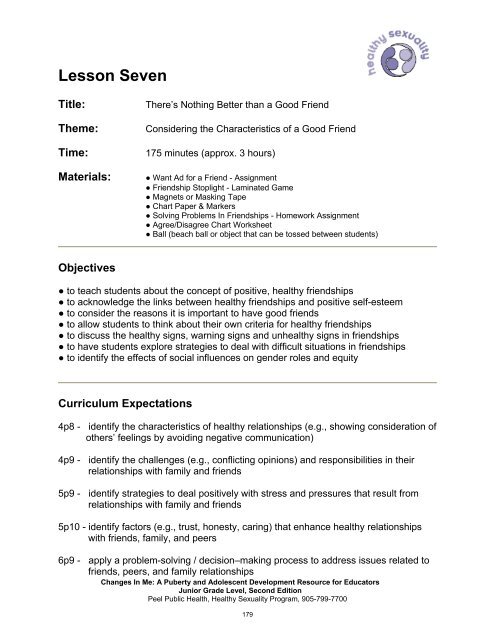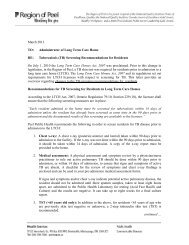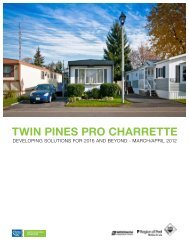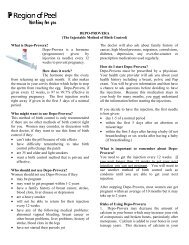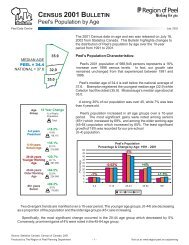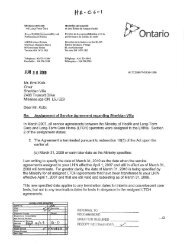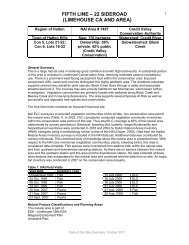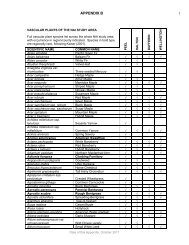Lesson Seven - There's Nothing Better than a Good Friend
Lesson Seven - There's Nothing Better than a Good Friend
Lesson Seven - There's Nothing Better than a Good Friend
Create successful ePaper yourself
Turn your PDF publications into a flip-book with our unique Google optimized e-Paper software.
<strong>Lesson</strong> <strong>Seven</strong><br />
Title: There’s <strong>Nothing</strong> <strong>Better</strong> <strong>than</strong> a <strong>Good</strong> <strong>Friend</strong><br />
Theme: Considering the Characteristics of a <strong>Good</strong> <strong>Friend</strong><br />
Time: 175 minutes (approx. 3 hours)<br />
Materials: ● Want Ad for a <strong>Friend</strong> - Assignment<br />
● <strong>Friend</strong>ship Stoplight - Laminated Game<br />
● Magnets or Masking Tape<br />
● Chart Paper & Markers<br />
● Solving Problems In <strong>Friend</strong>ships - Homework Assignment<br />
● Agree/Disagree Chart Worksheet<br />
● Ball (beach ball or object that can be tossed between students)<br />
Objectives<br />
● to teach students about the concept of positive, healthy friendships<br />
● to acknowledge the links between healthy friendships and positive self-esteem<br />
● to consider the reasons it is important to have good friends<br />
● to allow students to think about their own criteria for healthy friendships<br />
● to discuss the healthy signs, warning signs and unhealthy signs in friendships<br />
● to have students explore strategies to deal with difficult situations in friendships<br />
● to identify the effects of social influences on gender roles and equity<br />
Curriculum Expectations<br />
4p8 - identify the characteristics of healthy relationships (e.g., showing consideration of<br />
others’ feelings by avoiding negative communication)<br />
4p9 - identify the challenges (e.g., conflicting opinions) and responsibilities in their<br />
relationships with family and friends<br />
5p9 - identify strategies to deal positively with stress and pressures that result from<br />
relationships with family and friends<br />
5p10 - identify factors (e.g., trust, honesty, caring) that enhance healthy relationships<br />
with friends, family, and peers<br />
6p9 - apply a problem-solving / decision–making process to address issues related to<br />
friends, peers, and family relationships<br />
Changes In Me: A Puberty and Adolescent Development Resource for Educators<br />
Junior Grade Level, Second Edition<br />
Peel Public Health, Healthy Sexuality Program, 905-799-7700<br />
179
<strong>Lesson</strong> <strong>Seven</strong><br />
Background Information<br />
This lesson focuses on the issues young people face surrounding friendships during<br />
adolescence. This topic is important because while friendships are vital throughout life,<br />
peer groups and social relations among friends gain increasing importance during<br />
puberty and adolescence. As the peer group becomes a more significant source of<br />
influence, friendships begin to take on new meaning. During puberty, children will be<br />
making new friends at school and in social settings, and many will also be coping with<br />
evolving friendships from their earlier childhood. <strong>Friend</strong>ships are often put to the test<br />
during senior elementary and secondary school. Children struggle to maintain<br />
relationships with peers who may be changing in a variety of ways. Problems can occur<br />
when children form “cliques,” begin to “hang out” with different crowds, or when they<br />
simply grow apart from previous friends. Peer pressure can be a problem for<br />
adolescents. For example, sometimes young people who choose to use drugs and<br />
alcohol try to persuade their friends to do the same. Inevitably, the friends children<br />
choose will shape their experiences in critical ways.<br />
This lesson is designed to compel students to think about their own criteria for postive<br />
friendships, to discuss ways to evaluate friendships and to explore ways to deal with<br />
difficult situations in their friendships.<br />
Procedure<br />
Activity One: Class Discussion Regarding <strong>Friend</strong>ships - 30 minutes<br />
Tell your students that you will be discussing friendships during today’s lesson.<br />
Encourage students to participate frequently during the discussion, as their input on this<br />
topic is very important.<br />
Changes In Me: A Puberty and Adolescent Development Resource for Educators<br />
Junior Grade Level, Second Edition<br />
Peel Public Health, Healthy Sexuality Program, 905-799-7700<br />
180
<strong>Lesson</strong> <strong>Seven</strong><br />
Here are some ideas you may use to guide your discussion.<br />
● What kind of things can we do to begin and keep friendships?<br />
Join a club or a team. Meet a neighbour. Seek out a friend at school. Make contact<br />
with the person you would like to know better. Find ways to spend time with him/her.<br />
Talk about yourself, sharing more information as time goes by. Talk on the phone,<br />
write text and/or instant message or e-mail notes to your friend.<br />
● What is a friend? <strong>Friend</strong>s are people …<br />
…we feel close to. <strong>Friend</strong>s are people who have similar interests, people<br />
who care about us, and people we can trust. <strong>Friend</strong>s offer support and<br />
understanding when we really need it.<br />
● Last class, we talked a lot about self-esteem or feeling good about ourselves. How<br />
do you think self-esteem is related to friendships?<br />
When we feel good about ourselves, we are more likely to choose friends that<br />
are good for us. There is a saying that says, “we teach people how to treat us”.<br />
In other words, how we behave toward ourselves and other people gives them<br />
clues as to how they should behave towards us. If we feel good about ourselves<br />
and respect ourselves, and treat others with respect, we are showing people how<br />
we would like to be treated.<br />
● Why is it important to have good friends?<br />
True friendship is important. <strong>Friend</strong>s support one another, listen to each other<br />
and give advice. When you and your friend share personal information about<br />
yourselves, you can learn from each other and explore what you have in<br />
common and what makes you different. <strong>Friend</strong>s can teach us many things like<br />
how to play a game or how to make a craft. <strong>Friend</strong>s can introduce us to exciting<br />
things like delicious new foods and interesting customs or celebrations. You can<br />
also learn about acceptance by appreciating the different qualities that make us<br />
unique individuals. When you accept people for who they are, you are being a<br />
respectful friend.<br />
Changes In Me: A Puberty and Adolescent Development Resource for Educators<br />
Junior Grade Level, Second Edition<br />
Peel Public Health, Healthy Sexuality Program, 905-799-7700<br />
181
<strong>Lesson</strong> <strong>Seven</strong><br />
● What kinds of things do you like doing with your friends?<br />
Ideas might include: playing games (video) and sports, hanging out, having lunch<br />
together, attending Girl Guides, Boy Scouts or other community groups, going to<br />
classes together (e.g., dance, martial arts, music lessons), watching<br />
television/movies, using the computer, working on projects and/or doing<br />
homework together.<br />
● How can we be good friends?<br />
Share our interests and activities<br />
Trust each other and be honest<br />
Share our thoughts and feelings<br />
Respect each other’s opinions and beliefs<br />
Try to relate to how the other person feels<br />
Be sincere with each other<br />
Accept each other for who we are<br />
Encourage and support each other<br />
Commit to the friendship<br />
Activity Two: (2 parts)<br />
Part A: Ball Toss – 10 minutes<br />
This is a warm-up activity to help students explore the qualities of healthy relationships.<br />
Have the students stand up behind their desks or in a circle at the front of the room.<br />
Toss the ball to someone in the group, and ask them to call out a word that represents<br />
qualities of a healthy relationship (for example; trust, supportive, kind, fun…). Ask that<br />
person to then toss the ball to someone else. Each time a new student catches the ball,<br />
ask them to share a new quality… and so on.<br />
Part B: Want Ad for a <strong>Friend</strong> - 20 minutes<br />
Tell your students that you would like them to think about the characteristics that are<br />
most important in a friend. Distribute the assignment entitled, “Want Ad For A <strong>Friend</strong>”.<br />
Ask your students to complete this assignment individually. Allow students ten to fifteen<br />
minutes of quiet writing time. Once students have written the advertisement, ask some<br />
students to share their work by reading aloud to the class. (<strong>Friend</strong>ship Want Ad<br />
handout can be found following this lesson)<br />
Changes In Me: A Puberty and Adolescent Development Resource for Educators<br />
Junior Grade Level, Second Edition<br />
Peel Public Health, Healthy Sexuality Program, 905-799-7700<br />
182
<strong>Lesson</strong> <strong>Seven</strong><br />
Activity Three: <strong>Friend</strong>ship Stoplight Game - 30 minutes<br />
Here are the instructions to set up the <strong>Friend</strong>ship Stoplight Game. (The Stoplight game<br />
cards can be found following this lesson).<br />
Changes In Me: A Resource For Educators On Puberty And Adolescent Development<br />
Peel Health Department: Healthy Sexuality Program – Contact Health Line Peel @ 905-799-7700<br />
Changes In Me: A Resource For Educators On Puberty And Adolescent Development<br />
Peel Health Department: Healthy Sexuality Program – Contact Health Line Peel @ 905-799-7700<br />
Changes In Me: A Resource For Educators On Puberty And Adolescent Development<br />
Peel Health Department: Healthy Sexuality Program – Contact Health Line Peel @ 905-799-7700<br />
On the top left corner of your board or wall space, use tape<br />
or magnets to attach the red stoplight card that reads,<br />
“These are bad signs in a friendship”.<br />
Place the corresponding yellow and green stoplights<br />
underneath, like in a street stoplight.<br />
Shuffle the stoplight scenario cards to<br />
ensure that they are not in order.<br />
The graphic shown below appears on each scenario card.<br />
The object of this game is to decide which scenarios are most<br />
compatible with each of the following three statements: “these are<br />
bad signs in a friendship”, “these are warning signs in a friendship”<br />
and “these are good signs in a friendship”.<br />
Attach the appropriate answers to the board/wall beside the corresponding stoplight<br />
with tape or magnets.<br />
There are several ways that you can play this game. You can read the scenarios aloud<br />
and ask students where they think they best belong. You can give scenarios out to<br />
groups of students and they can arrive at a consensus. You can place the scenarios on<br />
overheads or on the document arm and ask volunteers to give suggestions. You might<br />
also consider placing the scenarios around the room and asking for volunteers to place<br />
them beside the proper stoplight on the board.<br />
No matter what pedagogical strategy you use to play this game, be sure that you ask<br />
students for explanations regarding their choices. The most important part of this<br />
activity is the discussion around whether each scenario constitutes a good, a<br />
warning or a bad sign in a friendship. It is in this arena that students will be able to<br />
discuss their various points of view. Your role in this game is to facilitate and mediate<br />
the conversations of your students. When there is disagreement, you might choose not<br />
to place the scenario beside one statement, but rather choose to set it aside for further<br />
debate and discussion. If the scenario clearly represents a bad or warning sign, be sure<br />
to make this clear for your students.<br />
Changes In Me: A Puberty and Adolescent Development Resource for Educators<br />
Junior Grade Level, Second Edition<br />
Peel Public Health, Healthy Sexuality Program, 905-799-7700<br />
183
<strong>Lesson</strong> <strong>Seven</strong><br />
There are fifteen scenario cards. Five scenarios correspond with each coloured<br />
stoplight: red (unhealthy/bad signs), yellow (warning signs) and green (healthy/good<br />
signs).<br />
While there may be some discrepancies, the following is a list of suggested correct<br />
answers.<br />
RED LIGHT: These are unhealthy/bad signs in a friendship.<br />
1. You are afraid of your friend’s temper.<br />
2. Your friend criticizes you or people you care about.<br />
3. Your friend threatens to hurt you.<br />
4. Your friend bullies and makes fun of you or other kids at school.<br />
5. Your friend pressures you to do things you do not want to do.<br />
YELLOW LIGHT: These are warning signs in a friendship.<br />
6. You are nervous that if you tell your friend something personal, s/he will<br />
tell other people at school.<br />
7. Your friend sometimes makes fun of you.<br />
8. You rarely get to plan what the two of you will do together.<br />
9. Your friend tells you not to hang out with certain people.<br />
10. You say that you agree with your friend, even when you really don’t. You are<br />
afraid they won’t be your friend anymore if you disagree.<br />
GREEN LIGHT: These are healthy/good signs in a friendship.<br />
11. You usually feel happy when you are with this person.<br />
12. Your friend respects your feelings and your opinions.<br />
13. Your friend talks to you about his/her feelings.<br />
14. Your friend is happy when good things happen to you.<br />
15. You enjoy being with this person, but you also enjoy spending time with other<br />
friends.<br />
Activity Four: Solving Problems In <strong>Friend</strong>ships Homework Assignment - 5 minutes<br />
Distribute the homework assignment. Remind your students about the IDEAL Decision-<br />
Making Model to which they were introduced to in <strong>Lesson</strong> Five. (If you have not yet<br />
used the model, please refer to <strong>Lesson</strong> Five for a detailed explanation.) While it is not<br />
necessary, they could use the IDEAL Decision-Making Model to guide their answers.<br />
Changes In Me: A Puberty and Adolescent Development Resource for Educators<br />
Junior Grade Level, Second Edition<br />
Peel Public Health, Healthy Sexuality Program, 905-799-7700<br />
184
<strong>Lesson</strong> <strong>Seven</strong><br />
Activity Five: Putting Girls and Boys In Boxes – 80 Minutes*<br />
* Adapted with permission from Rainbows and Triangles: A Curriculum Document for<br />
Challenging Homophobia and Heterosexism in the K-6 Classroom; Toronto District School Board<br />
& Elementary Teachers of Toronto, 2002.<br />
Activity Overview:<br />
In the following activity, the class has an opportunity to explore and examine the ways<br />
gender-role expectations limit and hurt both sexes. In group discussions, students<br />
develop lists of expectations based on gender and as a whole class, begin to challenge<br />
these ideas. As a final task, the class develops an action plan to challenge gender-role<br />
stereotyping in their classroom and school.<br />
Teacher Note: Because of the content and level of discussion involved, activity five<br />
may not be suitable for grade levels under five. The class should have plenty of<br />
previous experience working and solving problems in small groups.<br />
PART A:<br />
1. To begin this activity, have students complete the “Agree or Disagree” chart<br />
independently (Blackline master of this chart can be found at the end of this<br />
lesson). Encourage students to answer honestly and then in pairs, discuss their<br />
responses. Encourage students to provide each other with reasons for their<br />
answers. Give the class a few minutes (e.g., five to seven minutes) to complete<br />
this task. The “Agree or Disagree” chart provides an anticipation guide to assist<br />
students in assessing their own knowledge and ideas about the topic of gender<br />
roles before study. The following are notes on this teaching/learning strategy:<br />
An anticipation guide is a series of statements with which the students must agree or<br />
disagree with and support his/her response with reasons. An anticipation guide:<br />
Activates prior knowledge;<br />
Supports students in questioning the accuracy of their knowledge;<br />
Helps identify student misconceptions;<br />
Provides students with a purpose for reading/viewing/listening;<br />
Is used individually, but opportunities need to be provided for sharing and<br />
comparing responses;<br />
Builds students’ confidence that they are already familiar with areas of the<br />
topic;<br />
Assists students in making predictions about the topic.<br />
Changes In Me: A Puberty and Adolescent Development Resource for Educators<br />
Junior Grade Level, Second Edition<br />
Peel Public Health, Healthy Sexuality Program, 905-799-7700<br />
185
<strong>Lesson</strong> <strong>Seven</strong><br />
2. Spend a brief amount of time as a whole class sharing students’ responses. Ask<br />
for a show of hands about who agrees/disagrees with the statements and have<br />
volunteers share their reasons. Open the topic up for discussion, clarifying any<br />
misconceptions.<br />
PART B:<br />
3. Organize the students into mixed or same gender groups of four or five. Explain<br />
that each person in the group is to have a specific task. If the class has had<br />
experience formulating group responsibilities, assign the following roles:<br />
- 2 recorders (record the information)<br />
- 1 organizer (keeps time, encourages people to stay focused)<br />
- 1 idea seeker (reminds students of the task, asks group for ideas, etc.).<br />
4. When these tasks have been distributed among the groups, pass out one piece<br />
of flipchart paper and two markers to each group and ask the recorders to copy<br />
the following diagram in the middle of the chart paper:<br />
5. Divide the class into two. One half focuses on the male roles and the other half<br />
on female roles. (If the class consists of six small groups, three are assigned the<br />
task of male roles and three female roles.) Regardless, each group works on its<br />
own chart, focusing on one gender.<br />
6. Instruct students to fill in the inner square with words or ideas that express all the<br />
things that only boys/males or girls/females can do/be or are supposed to do/be.<br />
Have them leave the inner circle blank for now. Explain that these items should<br />
reflect what students have been taught, either directly or indirectly, by parents,<br />
teachers, siblings and friends. The list does not reflect what is necessarily true.<br />
Many of these items may be stereotypes of untrue expectations (e.g.,<br />
girls/women are soft, sweet, etc.; boys/men are strong, don’t cry, like sports,<br />
etc.). Provide approximately five to ten minutes to complete this task.<br />
Changes In Me: A Puberty and Adolescent Development Resource for Educators<br />
Junior Grade Level, Second Edition<br />
Peel Public Health, Healthy Sexuality Program, 905-799-7700<br />
186
<strong>Lesson</strong> <strong>Seven</strong><br />
7. Bring the class together. Ask each group to report back its list (adding only what<br />
has not already been stated from the other groups). Compile two master lists –<br />
one for males and one for females – on the board or chart paper as students<br />
share their brainstorm. In the following discussion, consider the following<br />
questions:<br />
Do you think it’s reasonable for all boys/males and girls/females to act in<br />
these ways?<br />
Are there people we know who fit within this square?<br />
Are there people we know who do not fit within this square?<br />
What is it called when we make assumptions and put expectations on<br />
certain individuals or groups based on their gender?<br />
8. At this point, define gender-role stereotyping with students:<br />
Gender-role stereotyping: the assumption that males and females are limited<br />
by gender in their interests, capabilities and accomplishments. It is the<br />
expectation that being a male or female biologically limits what one can do as a<br />
human being.<br />
Simplified version: thinking that boys can do only some things and should be<br />
interested in only some things just because they are boys, and thinking that girls<br />
can do only some things and should be interested in only some things just<br />
because they are girls.<br />
9. Record an appropriate definition for the class so that it is visible in the classroom.<br />
10. Have students return to their working groups. Before starting the next task, ask<br />
the recorders to write in the inner circle the word “gender-role stereotyping”<br />
e.g.;<br />
Changes In Me: A Puberty and Adolescent Development Resource for Educators<br />
Junior Grade Level, Second Edition<br />
Peel Public Health, Healthy Sexuality Program, 905-799-7700<br />
187
<strong>Lesson</strong> <strong>Seven</strong><br />
PART C:<br />
11. For the next task, have students insert words and ideas they think of if boys/girls<br />
don’t fit into what is in the box. (e.g., what happens if a girl/female is not skinny,<br />
sweet, doesn’t like shopping, and likes to build things, etc.? What happens if a<br />
boy/male is not strong, cries, doesn’t like sports, likes to cook, etc.?) Ask<br />
students to consider specific slurs or put-downs that are used, assumptions<br />
people may have about the girl/boy, negative behaviours towards the person not<br />
fitting into the gender role.<br />
Teacher Note: Be sure to create a safe environment by letting students know that<br />
it’s okay to use slang and/or inappropriate language for the purpose of<br />
deconstructing myths and stereotypes. You may want to discuss this lesson<br />
(language use) with your administrator prior implementing this activity.<br />
For example:<br />
12. As a whole class, discuss the students’ results. List in categories the ideas that<br />
groups came up with. Create headings, and record appropriate items under the<br />
headings as students share.<br />
Changes In Me: A Puberty and Adolescent Development Resource for Educators<br />
Junior Grade Level, Second Edition<br />
Peel Public Health, Healthy Sexuality Program, 905-799-7700<br />
188
<strong>Lesson</strong> <strong>Seven</strong><br />
For example:<br />
Ideas (stereotyping)<br />
Boys/males who don’t “fit in”<br />
Behaviours (discrimination) Attitudes (prejudice)<br />
Wants to be/act like Name-calling (sissy, Disliked or hated<br />
a girl<br />
faggot, gay)<br />
Is gay, homosexual Left out<br />
Likes boys<br />
Picked on, beaten up<br />
13. Share ideas with the class as to how the victim might feel if these thoughts,<br />
behaviours and negative attitudes were targeted at him/her (e.g., sad, isolated,<br />
angry, ashamed, embarrassed, etc…). What might he/she do to get away from<br />
this treatment? (e.g., change to be something he/she is not, pretend to be<br />
different, fight back, become violent and angry, change schools, become<br />
isolated, depressed, etc.)<br />
Discuss the ways that gender-role stereotyping hurts everybody: males and females.<br />
Ask students to provide examples of times that they, or someone they know, have<br />
stepped out of the traditional gender role in their lives (e.g., males cooking or taking<br />
care of younger siblings, females being athletic or working in construction).<br />
Possible Extensions<br />
Once their homework assignments have been submitted, think about having students<br />
role-play their way through some of the “friendship problems”. Consider having<br />
classmates judge their performances, offering alternative suggestions for solving the<br />
problems.<br />
Activity Five – Possible Extensions:<br />
1. In groups, create posters that express messages of gender equity and antihomophobia<br />
education to place around the school.<br />
2. Read stories of same-sex families or gay/lesbian and bisexual characters (refer<br />
to the sexual orientation section in the introduction/teacher guide section).<br />
3. Research how gender-role stereotyping and homophobic attitudes are<br />
perpetuated in our society (e.g., peer behaviour, parents, media, religion).<br />
Changes In Me: A Puberty and Adolescent Development Resource for Educators<br />
Junior Grade Level, Second Edition<br />
Peel Public Health, Healthy Sexuality Program, 905-799-7700<br />
189
<strong>Lesson</strong> <strong>Seven</strong><br />
Possible Assessment<br />
Two opportunities for formal, summative evaluation are presented in this lesson: the<br />
“Want Ad for A <strong>Friend</strong>” assignment and the “Solving Problems In <strong>Friend</strong>ships”<br />
homework assignment. As well, if students complete the role-play activity, they could<br />
evaluate themselves or their peers.<br />
Activity Five – Possible Assessment:<br />
1. Group Discussion/Chart Work -<br />
Do students work effectively and co-operatively in their group?<br />
Do they share and listen to each other’s opinions and ideas?<br />
Are they able to incorporate prior knowledge of issues (e.g., vocabulary<br />
and ideas related to equity)?<br />
2. Development of Action Plan –<br />
Do student understand equity concepts and vocabulary and are they<br />
able to utilize the knowledge in a practical way?<br />
Changes In Me: A Puberty and Adolescent Development Resource for Educators<br />
Junior Grade Level, Second Edition<br />
Peel Public Health, Healthy Sexuality Program, 905-799-7700<br />
190
Want Ad For A <strong>Friend</strong><br />
We are a young couple who is looking<br />
to adopt a puppy. We would like to<br />
add a golden retriever to our family.<br />
The puppy should like children and<br />
should enjoy going on long walks.<br />
Changes In Me: A Puberty and Adolescent Development Resource for Educators<br />
Junior Grade Level, Second Edition<br />
Peel Public Health, Healthy Sexuality Program, 905-799-7700<br />
Assignment<br />
Date: ______________ Name: ______________<br />
I am an eleven-year-old girl who is<br />
looking for a friend who is also in grade<br />
six. I would like my new friend to play<br />
volleyball with me. This person should<br />
be funny, honest and a good listener.<br />
Have you ever seen a want ad in the newspaper or online? Sometimes people who are<br />
looking to adopt a pet write ads describing the type of pet they are hoping to find. Other<br />
times, adults write want ads if they are looking to find a friend. Pretend that you are<br />
trying to make a new friend. Write an ad that describes a friend you would like to find.<br />
Think about what age you would like this person to be. Does it matter if the friend is a<br />
girl or a boy? What personality traits are you looking for in a friend? What kind of<br />
person do you think would make a great friend? Are there any activities that you would<br />
like to share with this new friend? If you spend a lot of time rollerblading, you might<br />
want a friend to share this activity with you. Think about all the things you need in a<br />
good friend. Today, you will be writing a want ad for a friend. This is how your written<br />
assignment will be marked.<br />
Criteria poor fair good very<br />
good<br />
Student completed at least five full sentences<br />
Response shows evidence of careful consideration of<br />
characteristics desired in a friend<br />
Quality of written work including spelling and grammar<br />
excellent<br />
Grade out of 15 ………………………………………………………………..... / 15<br />
191
Want Ad For A <strong>Friend</strong><br />
In the space provided below, write a want ad for your new friend.<br />
Make sure that you write at least five full sentences.<br />
Use your best spelling and grammar.<br />
Changes In Me: A Puberty and Adolescent Development Resource for Educators<br />
Junior Grade Level, Second Edition<br />
Peel Public Health, Healthy Sexuality Program, 905-799-7700<br />
Assignment<br />
Total Grade out of 15 ………………………………………………………. / 15<br />
192
Changes In Me: A Puberty and Adolescent Development Resource for Educators<br />
Junior Grade Level, Second Edition<br />
193<br />
Peel Public Health, Healthy Sexuality Program, 905-799-7700
Changes In Me: A Puberty and Adolescent Development Resource for Educators<br />
Junior Grade Level, Second Edition<br />
194<br />
Peel Public Health, Healthy Sexuality Program, 905-799-7700
Changes In Me: A Puberty and Adolescent Development Resource for Educators<br />
Junior Grade Level, 195<br />
Second Edition<br />
Peel Public Health, Healthy Sexuality Program, 905-799-7700
You are<br />
afraid of<br />
your<br />
friend’s<br />
temper.<br />
Changes In Me: A Puberty and Adolescent Development Resource for Educators<br />
196<br />
Junior Grade Level, Second Edition<br />
Peel Public Health, Healthy Sexuality Program, 905-799-7700
Your friend<br />
criticizes<br />
you or<br />
people you<br />
care about.<br />
Changes In Me: A Puberty and Adolescent Development Resource for Educators<br />
197<br />
Junior Grade Level, Second Edition<br />
Peel Public Health, Healthy Sexuality Program, 905-799-7700
Your<br />
friend<br />
threatens<br />
to hurt<br />
you.<br />
Changes In Me: A Puberty and Adolescent Development Resource for Educators<br />
198<br />
Junior Grade Level, Second Edition<br />
Peel Public Health, Healthy Sexuality Program, 905-799-7700
Your friend<br />
bullies and<br />
makes fun<br />
of you or<br />
other kids at<br />
school.<br />
Changes In Me: A Puberty and Adolescent Development Resource for Educators<br />
199<br />
Junior Grade Level, Second Edition<br />
Peel Public Health, Healthy Sexuality Program, 905-799-7700
Your friend<br />
pressures<br />
you to do<br />
things you do<br />
not want to<br />
do.<br />
Changes In Me: A Puberty and Adolescent Development Resource for Educators<br />
200<br />
Junior Grade Level, Second Edition<br />
Peel Public Health, Healthy Sexuality Program, 905-799-7700
You are nervous<br />
that if you tell<br />
your friend<br />
something<br />
personal, s/he<br />
will tell other<br />
people at<br />
school.<br />
Changes In Me: A Puberty and Adolescent Development Resource for Educators<br />
201<br />
Junior Grade Level, Second Edition<br />
Peel Public Health, Healthy Sexuality Program, 905-799-7700
Your friend<br />
sometimes<br />
makes fun<br />
of you.<br />
Changes In Me: A Puberty and Adolescent Development Resource for Educators<br />
202<br />
Junior Grade Level, Second Edition<br />
Peel Public Health, Healthy Sexuality Program, 905-799-7700
You rarely<br />
get to plan<br />
what the<br />
two of you<br />
will do<br />
together.<br />
Changes In Me: A Puberty and Adolescent Development Resource for Educators<br />
203<br />
Junior Grade Level, Second Edition<br />
Peel Public Health, Healthy Sexuality Program, 905-799-7700
Your friend<br />
tells you not<br />
to hang out<br />
with certain<br />
people.<br />
Changes In Me: A Puberty and Adolescent Development Resource for Educators<br />
204<br />
Junior Grade Level, Second Edition<br />
Peel Public Health, Healthy Sexuality Program, 905-799-7700
You say that you<br />
agree with your<br />
friend, even when<br />
you really don’t.<br />
You are afraid they<br />
won’t be your friend<br />
anymore if you<br />
disagree.<br />
Changes In Me: A Puberty and Adolescent Development Resource for Educators<br />
205<br />
Junior Grade Level, Second Edition<br />
Peel Public Health, Healthy Sexuality Program, 905-799-7700
You usually<br />
feel happy<br />
when you<br />
are with<br />
this person.<br />
Changes In Me: A Puberty and Adolescent Development Resource for Educators<br />
206<br />
Junior Grade Level, Second Edition<br />
Peel Public Health, Healthy Sexuality Program, 905-799-7700
Your friend<br />
respects<br />
your<br />
feelings and<br />
your<br />
opinions.<br />
Changes In Me: A Puberty and Adolescent Development Resource for Educators<br />
207<br />
Junior Grade Level, Second Edition<br />
Peel Public Health, Healthy Sexuality Program, 905-799-7700
Your friend<br />
talks to<br />
you about<br />
his/her<br />
feelings.<br />
Changes In Me: A Puberty and Adolescent Development Resource for Educators<br />
208<br />
Junior Grade Level, Second Edition<br />
Peel Public Health, Healthy Sexuality Program, 905-799-7700
Your friend<br />
is happy<br />
when good<br />
things<br />
happen to<br />
you.<br />
Changes In Me: A Puberty and Adolescent Development Resource for Educators<br />
209<br />
Junior Grade Level, Second Edition<br />
Peel Public Health, Healthy Sexuality Program, 905-799-7700
You enjoy<br />
being with this<br />
person, but<br />
you also enjoy<br />
spending time<br />
with other<br />
friends.<br />
Changes In Me: A Puberty and Adolescent Development Resource for Educators<br />
210<br />
Junior Grade Level, Second Edition<br />
Peel Public Health, Healthy Sexuality Program, 905-799-7700
Solving Problems In <strong>Friend</strong>ships<br />
Homework Assignment<br />
Everyone will have some difficult times in their friendships. Even in the best of<br />
friendships, problems do arise. It is important that you are able to know the difference<br />
between good friendships and not-so-good friendships. One way you can do this is to<br />
decide if the problems you face with your friend are “warning signs” or “unhealthy/bad<br />
signs” in your friendship. By now, you have played the <strong>Friend</strong>ship Stoplight Game with<br />
your class. Remember that “warning signs” make you feel a little worried about your<br />
friendship, while “bad signs” make you feel very uncomfortable.<br />
Think of a time when you had a problem with a friend. For this homework assignment,<br />
you will be writing a solution to a problem in a friendship. The solution can be<br />
something you actually did to solve a problem, or it can be something you might do if<br />
the problem came up again. If you cannot think of a problem in your own life, please<br />
provide a solution to either Caitlin’s or Taylor’s problem which are listed on the following<br />
page.<br />
On a lined piece of paper, complete all three tasks below.<br />
Task # 1: In one or two sentences, describe the problem you faced with your friend<br />
OR write down that you will be trying to solve Caitlin’s or Taylor’s<br />
problem.<br />
Task # 2: Explain why you think the problem is a “warning sign” or a “bad sign”.<br />
Task # 3: Write a solution that you used, or that a person could use, to solve the<br />
problem. If you are not sure how to solve the problem, try writing a few<br />
ideas that you think might work.<br />
Changes In Me: A Puberty and Adolescent Development Resource for Educators<br />
Junior Grade Level, Second Edition<br />
Peel Public Health, Healthy Sexuality Program, 905-799-7700<br />
211
Solving Problems In <strong>Friend</strong>ships<br />
Caitlin’s Problem:<br />
Homework Assignment<br />
Caitlin and Suli are best friends. They see each other every day at school and<br />
sometimes get together on the weekend. Two weeks ago, an exchange student named<br />
Heather joined their class. Caitlin likes Heather and she wants to be her friend. Suli is<br />
not happy about this. Suli is jealous of the attention Caitlin is paying Heather and she is<br />
nervous she will lose Caitlin’s friendship. Suli tells Caitlin not to be friends with Heather.<br />
Caitlin wants to be friends with both Suli and Heather. Caitlin is scared that Suli will be<br />
mad at her and stop being friends with her if she keeps spending time with Heather.<br />
How can Caitlin solve this problem in her friendship with Suli?<br />
Taylor’s Problem:<br />
Taylor and Lee are good buddies. They sit beside each other in class. Lee is really<br />
funny and he makes Taylor laugh. Sometimes, Lee acts like a “class clown”. Taylor<br />
likes school and is a good student. Lee struggles in school, usually goofs around during<br />
class and often gets in trouble with their teacher. When Taylor is trying to pay attention<br />
in class, Lee often talks to him and writes notes to him. Their teacher sent home a note<br />
to Taylor’s parents telling them that he is not paying attention in class. Taylor is not<br />
happy. He usually feels proud because he is a good student. Now, Taylor is nervous<br />
that his grades will drop but he is also worried that if he does not act like Lee, he will<br />
lose his friend.<br />
How can Taylor solve this problem in his friendship with Lee?<br />
Criteria poor fair good very<br />
good<br />
Student thoroughly completed all three tasks<br />
Quality of the solution(s) provided<br />
Changes In Me: A Puberty and Adolescent Development Resource for Educators<br />
Junior Grade Level, Second Edition<br />
Peel Public Health, Healthy Sexuality Program, 905-799-7700<br />
excellent<br />
Grade out of 10 ………………………………………………………………..... / 10<br />
212
Agree or Disagree?<br />
Changes In Me: A Puberty and Adolescent Development Resource for Educators<br />
Junior Grade Level, Second Edition<br />
Peel Public Health, Healthy Sexuality Program, 905-799-7700<br />
Worksheet<br />
Read the following statements by yourself. Check off whether you agree or<br />
disagree in column 1. Think about the reasons why. Then, share your<br />
answers with a classmate. Give reasons for your choices. After talking it<br />
over, if you change your mind, check off your second answer in column 2.<br />
COLUMN - 1 COLUMN - 2<br />
Statements Agree Disagree Agree Disagree<br />
1. Girls are<br />
different from<br />
boys.<br />
2. Girls are better<br />
babysitters <strong>than</strong><br />
boys.<br />
3. Bo ys are<br />
naturally better<br />
at sports.<br />
4. Being a<br />
secretary is a<br />
woman’s job.<br />
5. Being a<br />
construction<br />
worker is a<br />
man’s job.<br />
6. It’s not right for<br />
little boys to<br />
play with dolls.<br />
7. Little girls<br />
shouldn’t be<br />
playing with<br />
cars and trucks.<br />
213


